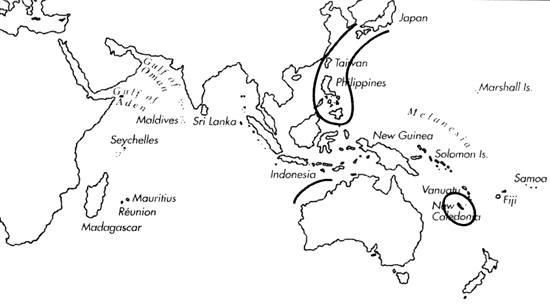
Skip Navigation Links
View access keys for this site.

Range: Japan to Philippines, recently reported from Vietnam; New Caledonia and Loyalty Is.; N. W. Australia.
Description: Medium-sized to large, moderately light to solid. Last whorl often slightly pyriform, also narrowly conical or narrowly conoid-cylindrical to sometimes conical or ventricosely conical; outline slightly convex adapically, concave to sometimes straight below. Shoulder usually carinate, with a rather deep exhalent notch. Spire high, stepped; outline almost straight. Larval shell of about 3 whorls, maximum diameter about 1.1 mm. First 8-10 postnuclear whorls tuberculate; tubercles continuing as axial costae below outer margins, weaker in late whorls and absent from last 0.5-2 whorls. Teleoconch sutural ramps variably concave, with distinct radial threads. Last whorl with weakly to deeply punctate spiral grooves and ribbons between; spiral sculpture usually absent from adapical fourth, sometimes restricted to basal third or half in large specimens. Subshoulder area with 2-3 closely set, usually fine spiral grooves generally also present in stepped preceding whorls.
| Shell Morphometry | ||
|---|---|---|
| L | 50-105 mm | |
| RW | 0.08-0.34 g/mm | |
| (L 50-86 mm) | ||
| RD | 0.43-0.52 | |
| PMD | 0.79-0.92 | |
| RSH | 0.23-0.29 | |
Ground colour white. Last whorl with 2-4 variably wide and variably solid spiral bands composed of variably confluent brown flecks or blotches and sparse, irregularly arranged spiral rows of brown dashes, spots or bars. Heavily maculated shells intergrade with sparsely maculated specimens. Larval shell and earliest postnuclear sutural ramps white. Following sutural ramps with brown spots at outer margin; spots may be absent from last whorl. Aperture white, occasionally with a brown adapical blotch deep within.
Periostracum yellowish olive to brown, thin, slightly translucent, with axial ridges on last whorl and sutural ramps.
Habitat and Habits: In 80-575 m.
Discussion: C. orbignyi is similar in most shell characters but has a more strongly sculptured last whorl, with distinct spiral ribbons and ribs from base to shoulder. The brown spots on its last whorl are more numerous and are typically axially aligned, while those of C. ichinoseana are sparser and spirally but not axially aligned. C. orbignyi also has distinct spiral sculpture on its sutural ramps, and often has stronger tubercles on the last whorl; its larval shell has more whorls (4 vs. 3). For the distinction from C. comatosa, see the Discussion of that species. The type specimen of C. i. prioris was dredged together with specimens of C. ichinoseana; Kuroda considered it an ancestral representative of this species. C. i. prioris differs from typical C. ichinoseana in having a relatively higher spire and a smoother surface. Its fossil status and subspecific status need substantiation.

C. ichinoseana range map
This section contains verbatim reproductions of the accounts of 316 species of Conus from the Indo-Pacific region, from Manual of the Living Conidae, by Röckel, Korn and Kohn (1995). They are reproduced with the kind permission of the present publisher, Conchbooks.
All plates and figures referred to in the text are also in Röckel, Korn & Kohn, 1995. Manual of the Living Conidae Vol. 1: Indo-Pacific Region.
The range maps have been modified so that each species account has it own map, rather than one map that showed the ranges of several species in the original work. This was necessary because each species account is on a separate page on the website and not confined to the order of accounts in the book.
Return to framed version (returns to search page)